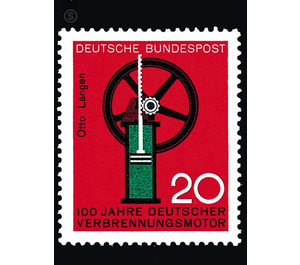Progress in technology and science - Germany / Federal Republic of Germany 1964 - 20
Theme: Post & Philately
| Country | Germany / Federal Republic of Germany |
| Issue Date | 1964 |
| Face Value | 20.00 |
| Color | red |
| Perforation | K 14 |
| Printing Type | Multicolor offset printing |
| Stamp Type | Postage stamp |
| Item Type | Stamp |
| Chronological Issue Number | 332 |
| Chronological Chapter | GER-BRD |
| SID | 500828 |
| In 85 Wishlists | |
In order to show the progress that humanity has made in the fields of technology and science since the middle of the last century, the Deutsche Bundespost is publishing this series of postage stamps. The graphic designers involved in the preparation of drafts were asked to illustrate the following facts in an appropriate manner on three different values: In 1865 August Friedrich Kekulé (1829-1896) published his benzene theory. As a brand topic, the benzene formula he discovered almost a century ago was chosen, which was of decisive importance for organic chemistry. In 1938, the proof of the German researchers Hahn and Strassmann that the atom was fissile, ushered in a new epoch of science and technology. It has a beneficial effect on humanity by using nuclear energy for peaceful purposes. To illustrate the nature of these new findings, the characteristic blue glow of a reactor in the operating state (Cerenkov radiation) should be shown. In 1863, Nikolaus August Otto (1832 to 1891) applied for a patent for his first atmospheric gas engine. This oldest German gas engine should be presented in a simplified form. Karl Oskar Blase, Hans Schweiss, Eduard J. Sauer and graphic designers Heinz and Hella Schillinger each delivered one, Hans Michael Heynen three series. The brief characterization of the task clearly shows what the difficulties were. It was a question of the brittle and less productive chemical symbols, the process of nuclear fission which is only manageable and intellectually permeable to a small circle of experts, and the object "motor", which for today's concepts is simple and highly tangible, in each case with an expression from graphic design language so to speak optically to name so that the group of brands not a dissonance, but a harmonious triad emerged. The job of the voter was to hear where the chord sounded best. All representations also had to withstand the technical test, so be correct. Contrary to expectations, the call for tenders produced a number of very remarkable achievements. As the most unified series, which at the same time met all scientific demands in a very special way, the proposals of Karl Oskar Blase were selected, which was also recognized by the Federal Minister of Posts and Telecommunications. The stamps were produced in multicolor offset printing at Bundesdruckerei Berlin.


